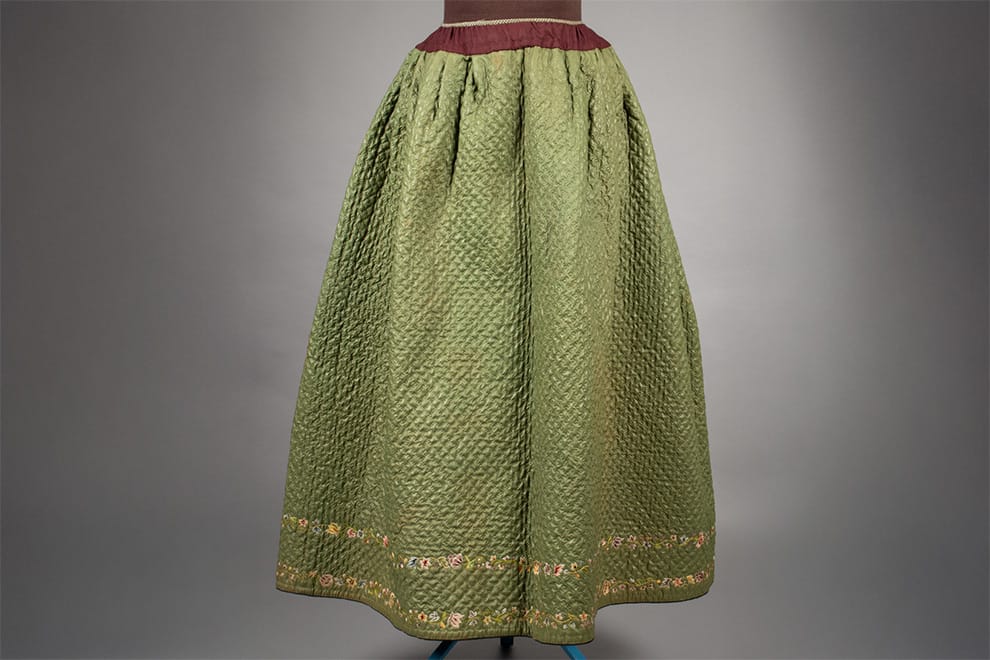ARTEFACT GALLERY #8
Den Grønne Stakken
Proposed by: Jonas Walsøe leader SKREI Research Center
Foundation Museum Nord - Norway


Technical Specifications
Name
Den Grønne Stakken / The Green Skirt
Tipology
Skirt/Dress
Authorship
Unknown *
Date or period:
c. 1770-1790 **
Materials:
Various fabrics, various threads, beeswax ***
Techniques:
Various ****
Country/ region:
Coastal Norwegian pattern, fabric and technique unknown, Europe.
Related links:
The Green skirt: Lower part of green stack with floral embroidery
For many centuries, the livelihood along the coast of Nordland has been the “jekte” trade, a trade link between north and south where jekte skippers in the north brought stockfish to Bergen and traded grain and other goods that they brought back home. Many people made themselves very rich from this trade. A family on Børøya in Hadsel left behind a large collection of objects and archives that allow us to take a deep dive into the life of a jekte family.
In the collection by the Bruun family, we have a skirt in glossy, matte-lacquered wool. It is thick and heavy in fabric, and probably well suited for winter use. The skirt probably belonged to either Maren (1736-1821) or Anne Marlene Bruun (1768-1860), fine ladies from the local upper class.
The entire skirt is handmade. The checkered pattern in the green outer fabric is stitched by hand, a work that took a lot of hours. Such a skirt would have been enormously expensive and something only the richest could have afforded. The glossy effect in the fabric was achieved with the help of beeswax. The exact method is lost to history.
Sources:
Elstad, Åsa. Threads from the past North Norwegian clothing and handicrafts in textiles. Museumsforlaget. 2023
DETAILS
The Green Skirt- Bruun Collection Museum Nord
Inspiration
Nordlandmuseet Jekt (boat) with stockfish by the dock in Bergen.
Location
* High class dress showing stockfish export and luxury import from Europe through old Hanse trading routes (Bergen/Trondheim) all the way up to Lofoten. For many centuries, the livelihood along the coast of Nordland has been the jekte trade, a trade link between north and south where jekte skippers in the north brought stockfish to Bergen and traded grain and other goods that they brought back home. Many people made themselves very rich from this trade. A family on Børøya in Hadsel left behind a large collection of objects and archives that allow us to take a deep dive into the life of a jekte family.
** The skirt was probably in use in the period approx. 1770-1790, and would have been worn with several layers of petticoats that gave volume, possibly a pannier, the predecessor of the 19th century crinoline.
In the collection by the Bruun family, we have a skirt in glossy, matte-lacquered wool. It is thick and heavy in fabric, and probably well suited for winter use. The skirt has probably belonged to either Maren (1736-1821) or Anne Marlene Bruun (1768-1860), fine ladies from the local upper class.
*** The entire skirt is handmade. The checkered pattern in the green outer fabric is stitched by hand, a work that took a lot of hours. Such a skirt would have been enormously expensive and something only the richest could have afforded. The glossy effect in the fabric was achieved with the help of beeswax. The exact method is lost to history.
**** The handiwork on the outside of the green skirt, the part people see, is done in very delicately executed handwork and luxurious materials. The green skirt was obviously a status garment. Everyone would be able to see that the woman who wore this skirt had means, and belonged to the upper echelons of society. The inside tells a slightly different story. Much coarser fabric and thread have been used there. Several different colorful ribbons and pieces of cloth are sewn together to make up the waistband. It appears that the maker took what was close at hand for the parts where it would not be visible to others. The work inside the skirt demonstrates a mentality of using up leftovers, and not wasting expensive fabrics where they won’t be visible to the common people. The skirt’s exterior opulence is balanced with a sobriety and thrift on the inside.

